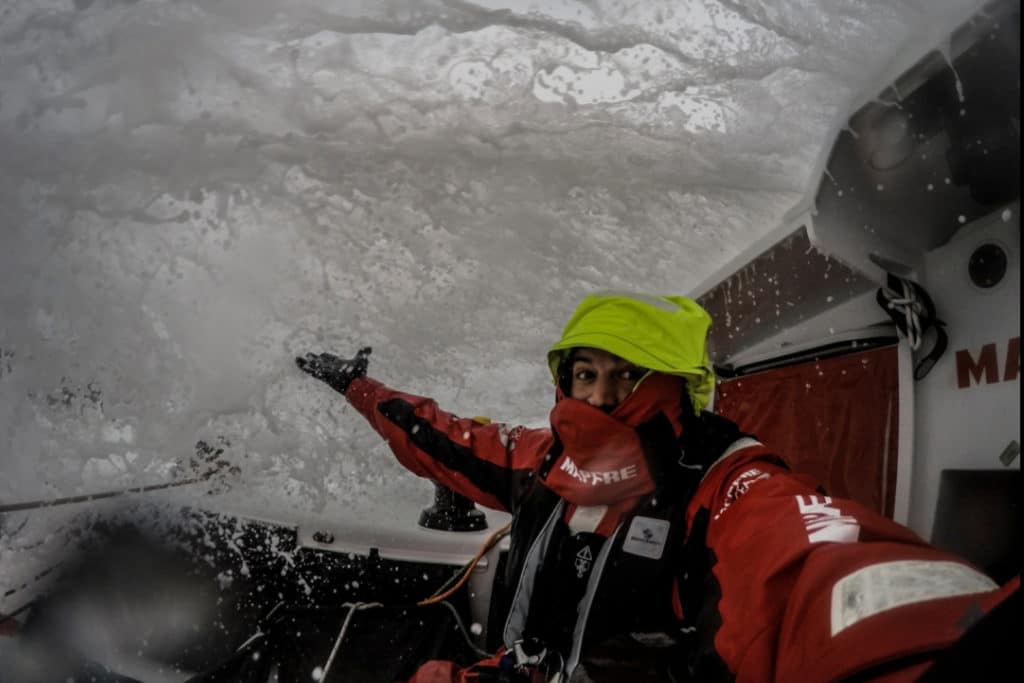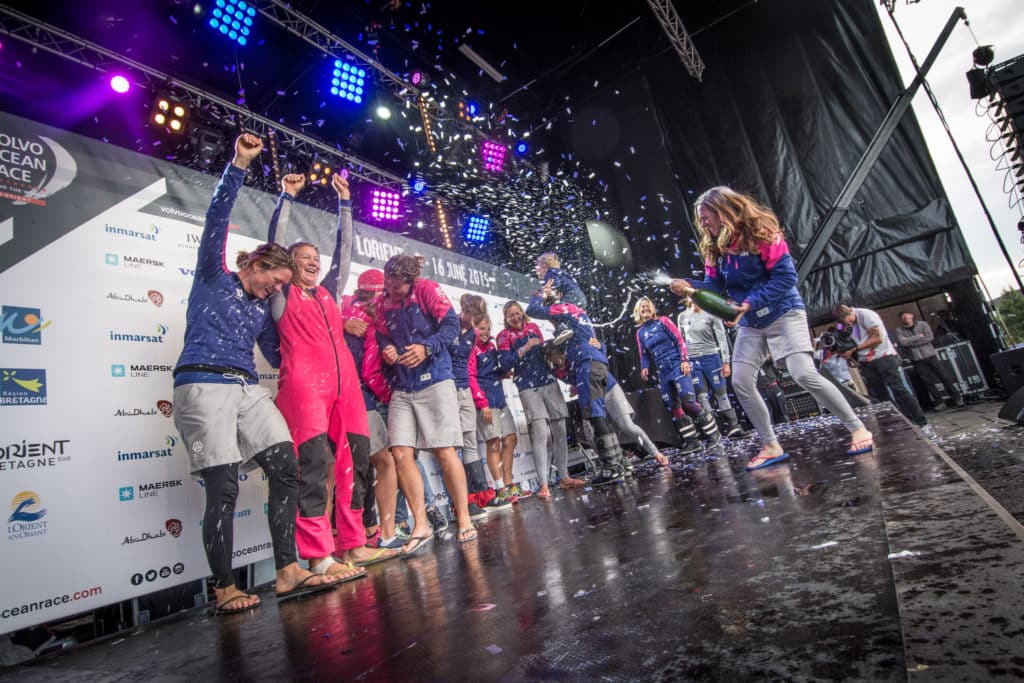
Organizers of the Volvo Ocean Race continue to reinvent the pre-eminent around-the-world team race before its October 2017 start. New CEO Mark Turner, a sports marketing specialist in sailing, announced 10 changes one year ahead of the fleet’s departure from Alicante, Spain. The first is already underway: the construction of a new, eighth Volvo 65. As for the rest, do they advance toward a better race for the sailors and fans alike? Yes and no.
Coerced Coed
The boldest initiative is to force female crewmembers into more teams. The inspirational all-female Team SCA was competitive at times in the previous edition, but the reality is all-male squads are faster as the miles add up — and there are a few seriously long legs in the next race. Turner’s goal is to handicap all-male teams by limiting them to seven crew. Other combinations are seven men and one or two women; seven women and one or two men; five men and five women; or 11 women.
There’s a catch: Teams can change crew combinations from leg to leg.
Turner’s intentions in providing “more opportunities for women” are commendable, but this contrived coed approach comes with all sorts of potential performance and financial inequalities. Plus, changing crew combinations from leg to leg, as proposed, undermines the value of a cohesive team. The attraction for many of the sailors is to start as a unit and finish as one, and historically, teams with the fewest crew rotations win. “It would be very hard to compete with only seven people on a Volvo Ocean 65 against teams of eight or nine,” says winning skipper Ian Walker. “This new rule will almost certainly force teams to hire women, and that will create a great platform for learning.” Several editions ago, however, organizers mandated under-30s onto the boats for similar reasons (too many old guys), so why not do the same for females?
Go for Broke
A combination of one-design boats, shared weather forecasts and rampant AIS intelligence-gathering is what made the previous race so predictable. There were rarely flyers, and there was little reason to ever break from the herd, which produced oceanic drag races and what Turner says was “extraordinarily close racing all the way around the world.”
Quite a few sailors bemoaned the relentless pursuit of one another around the world, so organizers have altered the scoring scheme to make it interesting. On the list of changes are position blackouts (aka stealth mode) and allowing navigators to “use more of their own judgment at certain times.”
The route’s longer ocean legs — two in the Southern Ocean and one in the North Atlantic — score double points, each leg win nets a bonus point, and there’s a bonus point for getting around Cape Horn first, as well as one for best overall elapsed time. While the new scoring is potentially confusing for the nonsailing fan base, real sailors will appreciate the desperation of sailing off to Cornersville to hunt for points.
Disembedded Reporters
“Not gonna work” is what one veteran Onboard Reporter says about a change to the OBR role. “Worst idea ever.” OBRs will now be race employees, assigned to teams and potentially shuffled throughout the race. First-generation OBRs, in 2008, were sailors with cameras and keyboards. In 2014, they were dedicated multimedia storytellers (and cooks) who were integral to the team fabric. Good OBRs capture the soul of their respective teams, which is easier said than done, and from deeper bonds comes more compelling content.

“It’s true that the OBRs will not be able to create the sort of long-term bond with their teams that they may have done in previous editions, and we could lose some of the storytelling opportunities that are provided by that kind of relationship,” says Turner, “but we believe that the ability to rotate the OBRs this way will provide a crucial distance between the teams and the OBRs that will better enable them to properly perform the role of observational journalist.” The critical word here is “distance.” As a divide grows between an embedded reporter and his subjects, the experience becomes more superficial.
Getting Social
With a “bespoke device” developed by race organizers, the idea is to open the onboard firewall to unfiltered social-media interaction — one way — between the sailors and their followers. Satellite hookup is ever present, so why not? A raw, emotional tweet about a 500-mile overnight burn is perfectly re-tweetable.
Pit Lanes in Ports
With a dedicated “boatyard” in place to service the boats once in port, the days of team-container shantytowns will be improved such that integrated team bases create a “pit row” for sponsor activation and a “more intimate” fan experience. To the benefit of teams and shore crews, organizers will build, dismantle and ship bases, which they say will require 60 percent fewer containers than the last edition. Ship less, save money, cut your emissions — that’s all good.
VIP Fleet
Extreme 40 catamarans were plugged into Volvo Ocean Race stopovers many years ago with the introduction of “stadium sailing.” Host ports and fans enjoyed them immensely because they provided a sailing spectacle while the raceboats sat idle. Turner created the Extreme Sailing Series, so it’s not surprising that he’s partnered with M32 cat builder Aston Harald to provide in-port toys for sponsors, VIPs, media and pro-am sailing. As part of its sponsor inventory, each team gets a cat and a support RIB to transfer guests. Taking the boss and his associates on a catamaran tear is good relations.
Leg Zero
The benefit of a one-design? Campaigns can get in cheaper and start late. The downside? Starting late. Yet that’s the nature of this biennial race: Sponsor hunts are long and unpredictable, most of the teams will emerge mere months before the start, and organizers will require teams to show up at England’s Cowes Week in August 2017 for “Leg Zero,” which will include the 600-mile Fastnet Race. Next is a race from England to Lisbon and a prologue from Lisbon to the start port of Alicante, Spain.
As there’s a loophole to the “mandatory” qualifiers, there’s nothing new here.
Tapping Hydropower
Obsessively adjusting the keel in marginal conditions burns through precious fuel, so in the last edition, teams relied on the discretionary use of wind generators to top off the juice. This time the goal is to capture the energy flow using hydrogenerators, which are supplied equipment. Organizers are considering periods of mandatory usage in order to reduce the amount of fuel required. Reliability will be key.
To Lisbon or Bust?
One sailor recently described the rare feeling of casting lines in Alicante while knowing one’s next stop was Cape Town, South Africa — which is “a long f—— way.” All that prerace pent-up energy can be bled over weeks at sea, he says. To this veteran and a few others, the thought of stepping ashore — only 700 miles later — for a full-blown stopover in Lisbon is a total buzzkill.
Read More Volvo Ocean Race News: Mapfre Returns | Australia Added to Stopovers









